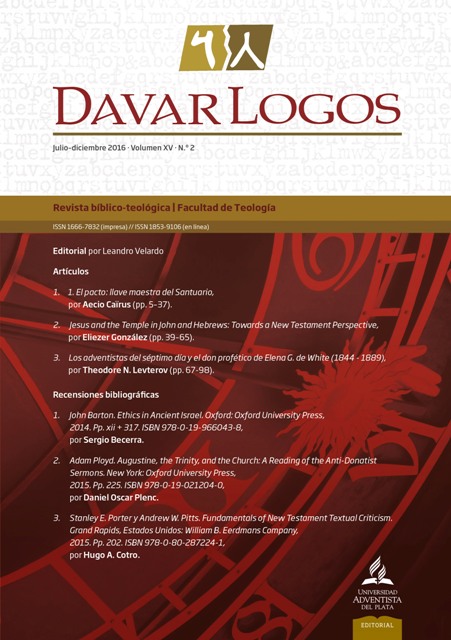El pacto: llave maestra del santuario
Keywords:
Pacto - Santuario - Historia del adventismo – Juan Calvino – Guillermo Miller - Hiram EdsonAbstract
ResumenEs fácil constatar en la Biblia el ministerio de Cristo en un santuario o templo (היכל) celestial, pero esta doctrina recibe resistencia por la incomprensión de su función. Hay un santuario celestial porque Dios tiene un pueblo al que está vinculado por su pacto. El templo es el centro de administración, a través de los siglos, de ese pacto para los creyentes individuales que llevan una vida acotada en el tiempo. Es en el lugar santo que se establece al creyente en el pacto mediante la participación en el banquete que sustenta la vida eterna ofrecido por el Rey a través de su propio sacrificio (el Calvario). El lugar santísimo es el locus del juicio final, en sus fases investigativas previa y posterior al advenimiento, y en la fase ejecutiva final. La apostasía en la cristiandad predicha en la profecía ocurrió al establecer una administración eclesiástica de un sistema de expiación paralelo, en la tierra. La doctrina bíblica fue recuperada con el aporte de figuras importantes del protestantismo y el adventismo, entre las que se destacan Juan Calvino, Guillermo Miller e Hiram Edson. AbstractIt is easy to demonstrate in the Bible the ministry of Christ in a sanctuary or temple (היכל) in heaven, but the doctrine is often resisted out of incomprehension of its function. There is a heavenly sanctuary because God is committed to a people through a covenant. The temple is, through the centuries, the center of administration of such covenant for individual believers, who have lives restricted in time. The establishment of the believer in the covenant occurs in the Holy Place by means of his or her participation in the eternal-life giving banquet the King offers through His own sacrifice (Calvary). The Most Holy is the place of Final judgment, in its pre-Advent and post-Advent investigative phases, and in its final executive phase. The prophesied apostasy in Christendom came about by establishing a churchly administration of a parallel system of atonement on earth. The Biblical doctrine was recovered with the contribution of important figures in Reformation and Adventism, especially by John Calvin, William Miller and Hiram Edson.Downloads
Download data is not yet available.




